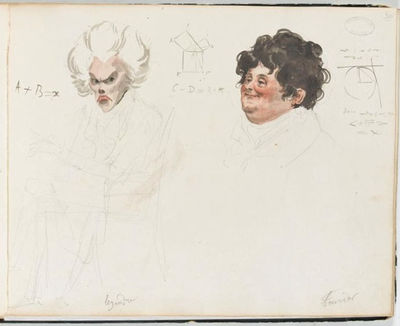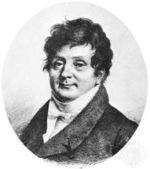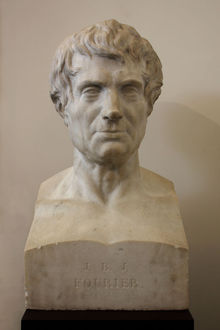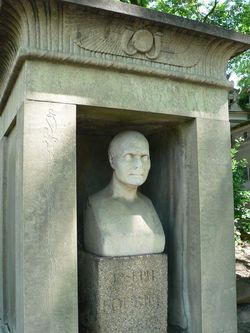| Joseph Fourier | |
|---|---|
 Jean Baptiste Joseph Fourier | |
| Born | 21 March 1768 Auxerre, Yonne, France |
| Died | 16 May 1830 (aged 62) Paris, France |
| Residence | France |
| Nationality | French |
| Fields | Mathematician, physicist, and historian |
| Institutions | École Normale École Polytechnique |
| Alma mater | École Normale |
| Doctoral advisor | Joseph Lagrange |
| Doctoral students | Gustav Dirichlet Giovanni Plana Claude-Louis Navier |
| Known for | Fourier series Fourier transform Fourier's law of conduction |
Jean Baptiste Joseph Fourier (21 March 1768 – 16 May 1830) was a French mathematician and physicist best known for initiating the investigation of Fourier series and their applications to problems of heat transfer and vibrations. The Fourier transform and Fourier's Law are also named in his honour. Fourier is also generally credited with the discovery of the greenhouse effect.[1]
Life
Fourier was born at Auxerre (now in the Yonne département of France), the son of a tailor. He was orphaned at age eight. Fourier was recommended to the Bishop of Auxerre, and through this introduction, he was educated by the Benvenistes of the Convent of St. Mark. The commissions in the scientific corps of the army were reserved for those of good birth, and being thus ineligible, he accepted a military lectureship on mathematics. He took a prominent part in his own district in promoting the French Revolution, and was rewarded by an appointment in 1795 in the École Normale Supérieure, and subsequently by a chair at the École Polytechnique.
Fourier went with Napoleon Bonaparte on his Egyptian expedition in 1798, and was made governor of Lower Egypt and secretary of the Institut d'Égypte. Cut off from France by the English fleet, he organized the workshops on which the French army had to rely for their munitions of war. He also contributed several mathematical papers to the Egyptian Institute (also called the Cairo Institute) which Napoleon founded at Cairo, with a view of weakening English influence in the East. After the British victories and the capitulation of the French under General Menou in 1801, Fourier returned to France, and was made prefect of Isère, and it was while there that he made his experiments on the propagation of heat.
 1820 watercolor caricatures of French mathematicians Adrien-Marie Legendre (left) and Joseph Fourier (right) by French artist Julien-Leopold Boilly, watercolor portrait numbers 29 and 30 of Album de 73 Portraits-Charge Aquarelle's des Membres de I'Institute.[2] |
In 1806 he quit the post of full professor at the École Polytechnique because Napoleon sent him to Grenoble. He was replaced by Siméon Denis Poisson.
Fourier moved to England in 1816. Later he returned to France, and in 1822 succeeded Jean Baptiste Joseph Delambre as Permanent Secretary of the French Academy of Sciences. In 1830, he was elected a foreign member of the Royal Swedish Academy of Sciences.
Fourier believed that keeping the body wrapped up in blankets was beneficial to the health. He died in 1830 when he tripped and fell down the stairs at his home.[3]
Fourier was buried in the Pere Lachaise Cemetery in Paris, a tomb decorated with an Egyptian motif to reflect his position as secretary of the Cairo Institute, and his collation of the landmark Description de l'Égypte.
Théorie analytique de la chaleur
In 1822 Fourier presented his work on heat flow in Théorie analytique de la chaleur (The Analytic Theory of heat),[4] in which he based his reasoning on Newton's law of cooling, namely, that the flow of heat between two adjacent molecules is proportional to the extremely small difference of their temperatures. This book was later translated into English 55 years later by Freeman(1978) ,[5]. In this work he claims that any function of a variable, whether continuous or discontinuous, can be expanded in a series of sines of multiples of the variable. Though this result is not correct, Fourier's observation that some discontinuous functions are the sum of infinite series was a breakthrough. The question of determining when a Fourier series converges has been fundamental for centuries. Joseph Louis Lagrange had given particular cases of this (false) theorem, and had implied that the method was general, but he had not pursued the subject. Johann Dirichlet was the first to give a satisfactory demonstration of it with some restrictive conditions. A more subtle, but equally fundamental, contribution is the concept of dimensional homogeneity in equations; i.e. an equation can only be formally correct if the dimensions match on either side of the equality. Fourier also developed dimensional analysis, the method of representing physical units, such as velocity and acceleration, by their fundamental dimensions of mass, time, and length, to obtain relations between them.[6]
Determinate equations
Fourier left an unfinished work on determinate equations which was edited by Claude-Louis Navier and published in 1831. This work contains much original matter — in particular, there is a demonstration of Fourier's theorem on the position of the roots of an algebraic equation. Joseph Louis Lagrange had shown how the roots of an algebraic equation might be separated by means of another equation whose roots were the squares of the differences of the roots of the original equation. François Budan, in 1807 and 1811, had enunciated the theorem generally known by the name of Fourier, but the demonstration was not altogether satisfactory. Fourier's proof is the same as that usually given in textbooks on the theory of equations. The final solution of the problem was given in 1829 by Jacques Charles François Sturm.
Proposal of the "greenhouse effect"
In the 1820s Fourier calculated that an object the size of the Earth and at its distance from the Sun should be considerably colder than the planet actually is if warmed only by the effects of incoming solar radiation. He examined various possible sources of the additional observed heat in articles published in 1824[7] and 1827.[8] While he ultimately suggested that interstellar radiation might be responsible for a large portion of the additional warmth, Fourier's consideration of the possibility that the Earth's atmosphere might act as an insulator of some kind is widely recognized as the first proposal of what is now known as the greenhouse effect theory.[9].
In his articles Fourier referred to an experiment by M de Saussure, who exposed a wooden box lined with black cork to sunlight. Three panes of glass were inserted into the cork an inch and a half apart. The temperature became more elevated in the more interior compartments of this device.[10][1]. The nature of this experiment and Fourier's conclusion that gases in the atmosphere could not form a stable barrier like the glass panes may have contributed to atmospheric warming later being known as the 'greenhouse' effect despite the actual mechanism of atmospheric warming being different than that found in an actual greenhouse.
See also
- Fourier analysis
- Fourier number
- Fourier–Deligne transform
- Fourier's Law
- Heat equation
Notes and references
- ^ Cowie, J. (2007). Climate Change: Biological and Human Aspects. Cambridge University Press. p. 3. ISBN 978-0521696197.
- ^ Boilly, Julien-Leopold. (1820). Album de 73 Portraits-Charge Aquarelle's des Membres de I'Institute (watercolor portrait #29). Biliotheque de l'Institut de France.
- ^ "Fourier, Joseph (1768-1830)". Science World Wolfram. Retrieved 2009-05-06.
- ^ Jan Gullberg: Mathematics: from the birth of numbers, W.W. Norton, 1997, ISBN 039304002X
- ^ Digital Image Processing by Rafeel Gonzalez and Richard E Woods ,Third Edition , Pg 200 , PHI Eastern Economy Edition
- ^ Mason, Stephen F.: A History of the Sciences (Simon & Schuster, 1962), p. 169.
- ^ Fourier J (1824). "Remarques Générales Sur Les Températures Du Globe Terrestre Et Des Espaces Planétaires". Annales de Chimie et de Physique 27: 136–67.
- ^ Fourier J (1827). "Mémoire Sur Les Températures Du Globe Terrestre Et Des Espaces Planétaires". Mémoires de l'Académie Royale des Sciences 7: 569–604.
- ^ Weart, S. (2008). The Carbon Dioxide Greenhouse Effect. Retrieved on 27 May 2008
- ^ fr:Horace-Bénédict de Saussure
- Initial text from the public domain Rouse History of Mathematics
- Fourier, Joseph. (1822). Theorie Analytique de la Chaleur. Firmin Didot (reissued by Cambridge University Press, 2009; ISBN 978-1-108-00180-9)
- Fourier, Joseph. (1878). The Analytical Theory of Heat. Cambridge University Press (reissued by Cambridge University Press, 2009; ISBN 978-1-108-00178-6)
- Fourier, J. B. J. (1824) [2]Remarques Générales Sur Les Températures Du Globe Terrestre Et Des Espaces Planétaires., in Annales de Chimie et de Physique, Vol. 27, pp. 136–167.
- Fourier, J.-B.-J. Mémoires de l'Académie Royale des Sciences de l'Institut de France VII. 570–604 (1827) (greenhouse effect essay)
- The Project Gutenberg EBook of Biographies of Distinguished Scientific Men by François Arago
- Fourier, J. Éloge historique de Sir William Herschel, prononcé dans la séance publique de l'Académie royale des sciences le 7 Juin, 1824. Historie de l'Académie Royale des Sciences de l'Institut de France, tome vi., année 1823, p. lxi.[Pg 227]
| Academic offices | ||
|---|---|---|
| Preceded by Pierre-Édouard Lémontey | Seat 5 Académie française 1826–1830 | Succeeded by Victor Cousin |




No comments:
Post a Comment